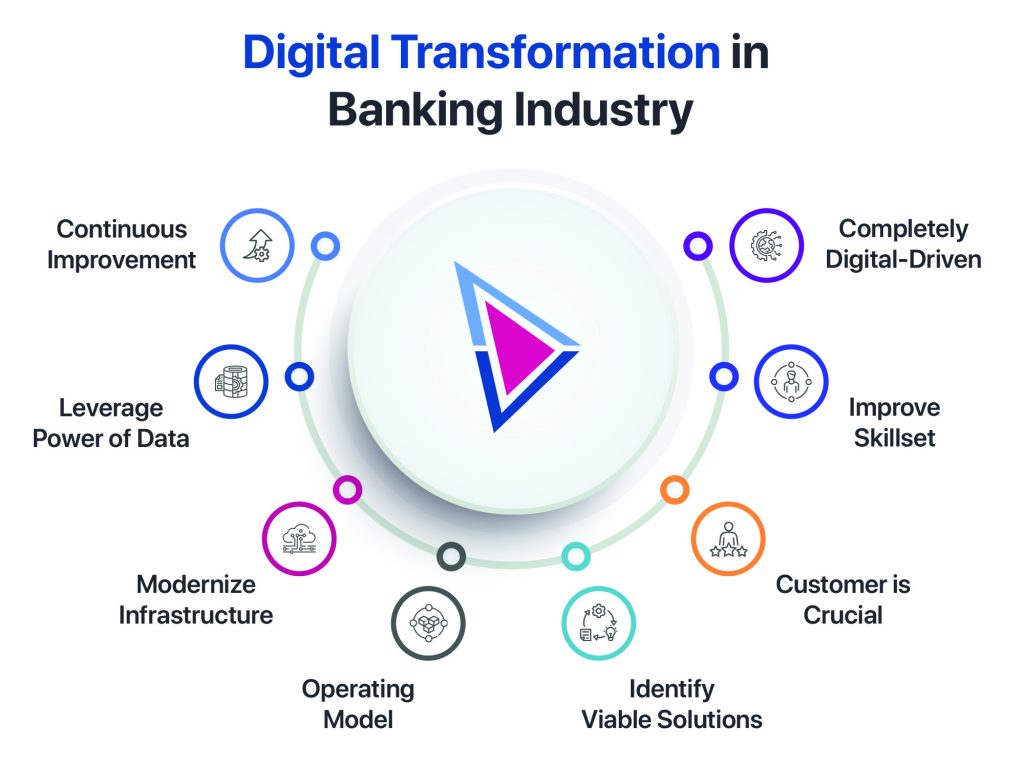Advantages and Challenges in Digital Transformation in Banking

As the digital transformation in Banking snowballs into an inflection arc, it is worth remembering that preparations for it didn’t happen in a vacuum. Information technology that boosts productivity and improves the bank’s process quality has been mainstream for a decade. The next stage – distribution – accelerated by the internet explosion (especially across the developmental economies) got an unexpected shot in the arm via the pandemic. Now, the tipping point nears as emergent technologies (especially AI, ML, 5G, and IoT) fundamentally change banks’ business models and user experience.
Banks at the Crossroads
Incumbent banks (global or regional) are like deers blinded by headlights on highways. On one side, riding on their scale and distribution prowess are the fintech start-ups and neo-banks, and on the other are the tech giants – the data masters – who, with their digital payment apps, are helping customers bypass credit or debit cards instruments (consider Ali Pay or WeChat Pay in China, as one example)
Advantages of Digital Transformation in Banking
- More value, quicker, at a lower cost. Traditional banks realize that the three variables – values, speed, and costs – are the lowest common denominator. More customers than ever are online, and the way they interact (with their banks)is changing fast. From rethinking business models to strategy shifts in customer acquisition to engaging customers via omnichannel platforms, legacy banks intend to seize advantages in the hypercompetitive market. Offering faster, cheaper, and more nuanced services are undeniably the most significant digital advantage.
- Ability to create meaningful experiences. Focused on expanding the convenience and cost-efficiencies, banks are reimagining the user experience. This could mean adopting front-end initiatives (making self-administration options friction-free) or back-end data architecture investments that replace out-of-sync customer information or even patching up the fragmented portions that jar user experience across channels. Said, embracing digital transformation is one way for banks to offer intuitive services by maximizing touchpoints.
- Opportunity to stand out from the competition. Embracing digital transformations allows banks a powerful window to reframe what “growth” means. One way for a legacy institution to seek a different future is via metrics and how they can translate operational metrics. Consider this. Instead of the standard performance measure of the rate of digital customer growth, a more realistic metric can be the ‘cost-to-income’ ratio. Another opportunity that digital transformation brings is the chance to cultivate a digital culture, both in terms of mindsets and organizational rituals.
Challenges of Digital Transformation in Banking
- Employee fears being replaced. Digital transformation gathers stiff resistance from employees who are skeptical (and detractive) of the entire operations. Rather than seeing the change as an opportunity to upgrade market-worthy skills, many employees – consciously or not – feel powerless. A practical and pre-emptive step is to gather employees ahead of time and help them map their influential past contributions to the components of the digital future. Doing so allows them to reclaim control of the situation.
- Digital Transformation is not about technology. Force-fitting or setting the business strategy after deciding on the transformation mandates is like putting the cart before the horse. Undoubtedly, banks are advised to focus on speed, innovation, and digitalization, but these levers are to be used in the service of an overarching growth plan and market-first aspiration. For instance, before a bank invests in virtual digital technology, it needs to be clear that it is a means to an end. This case quickens the speed-to-market by reducing the time from design to sampling.
- Piece-meal approach. Digital transformation practiced in its actual avatar is an all-encompassing endeavor. A comprehensive banking solution offers long-term rewards for banks engaged in retail, corporate, SME ops, or wealth management. This solution has components that interlock user experience management, identity & access management, process digitization, open banking via APIs, and cloud deployment. To minimize the risk of failure and unlock the full potential of digital transformation, banks need to conduct deep dives across technology, domain, digital methodologies, and other intellectual property.
To sum it up, digital transformation is today’s game-changer. Nevertheless, it has to be approached with knowledge and enthusiasm because market platforms, while critical, are insufficient for effecting a comprehensive on their own. Singular vision is indispensable for banks to achieve scale, sophistication, and agility in their unique transformation journeys.
View













